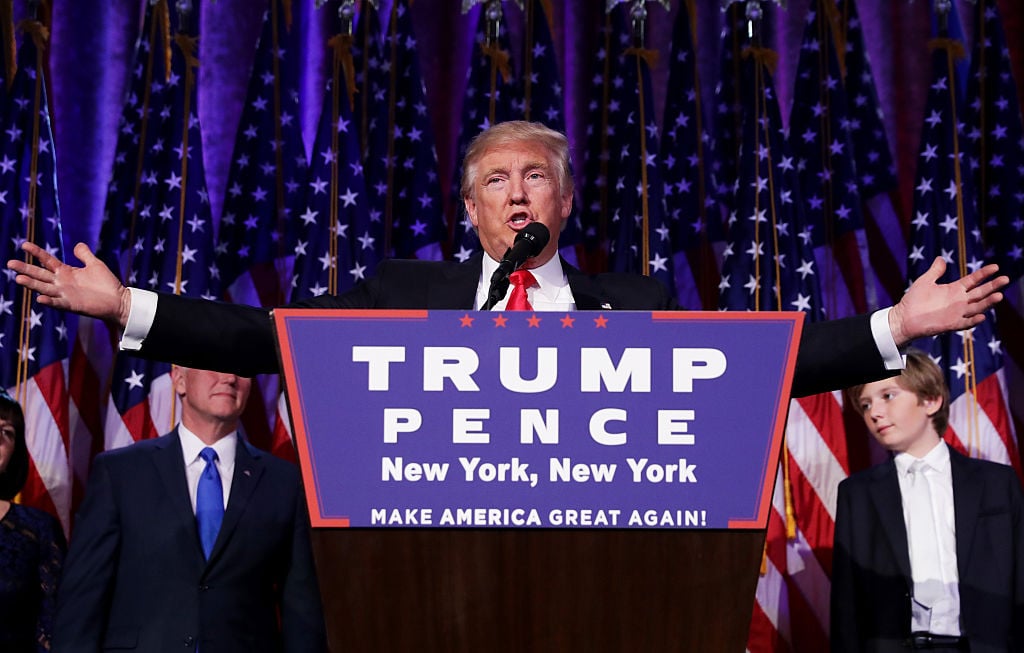
As financial markets react to Donald Trump’s shocking win in the US presidential election, expert observers are weighing possible outcomes for the art market. While art advisors, academics, and art dealers talking to artnet News today say it’s too soon to make concrete predictions, especially based on the vague and quicksilver nature of Trump’s policy proposals, they did offer some observations on what to look out for as we settle into the fact of the reality TV star as the Republican president-elect.
Markets have been volatile since the election went Trump’s way, diving last night but stabilizing today, further casting uncertainty on overall financial futures. In those circumstances, investors often look to tangible assets like gold and art, and some experts say that art could conceivably also look like an appealing place to park money amid the global uncertainly following Trump’s win.
Former Secretary of State Hillary Clinton speaks during a news conference at the New Yorker Hotel on November 9, 2016 in New York City. Hillary Clinton conceded the U.S. Presidency to Republican challenger Donald Trump. Photo Justin Sullivan/Getty Images.
As it happens, next week sees five major sales among the New York auction houses, including Impressionist, modern, postwar and contemporary art. The aggregate estimate for the evening sales at Christie’s, Sotheby’s, and Phillips New York is anywhere from $882 million to $1.2 billion. All the evening sales at the same houses last year totaled $2 billion.
Experts predict that the auctions will not be drastically altered by last night’s outcome.
“After everybody gets over the shock or elation, depending on one’s point of view, things may be up or down a little bit,” said New York art advisor Todd Levin in a phone interview. “But while I think Trump’s victory injects a modest amount of uncertainty, I don’t think that there is going to be any epic change in markets as that applies directly to the sales next week. That said, will the news put the auction houses on edge? Sure.”
Suzanne Gyorgy, global head of art advisory and finance at Citi Private Bank, similarly suggests that major, high-quality, rare works of art may fare well next week regardless of last night’s outcome.
Wassily Kandinsky, Rigide et courbé (1935). Courtesy Christie’s Images Ltd.
“The Wassily Kandinsky on offer at Christie’s is a once-in-a-lifetime opportunity,” she said via phone. “It hasn’t been on the market for 50 years, and it’s in pristine condition. It’s a powerful picture. The Monet haystacks painting is also once in lifetime, as it’s the last haystack in private hands.”
Gyorgy also looked to international collectors to continue to prop up the sale results.
“We’ll continue to see buyers from Latin America and Asia who have been working really hard building collections and have developed an eye for good works. I don’t see that changing.”
Claude Monet, Meule (1891). Courtesy Christie’s Images Ltd.
Levin was similarly sanguine.
“Whether they like Trump or don’t like Trump, a lot of what he is talking about with regards to tax rates and economic policy will possibly be very much in favor of the high net worth individuals who are major art buyers at evening sales,” Levin said. “Day sales, where buyers are on the lower economic rungs, may be more affected since those people are more exposed and nervous.”
Kim Oosterlinck, professor of finance at the Solvay Brussels School of Economics and Management at the Free University of Brussels, took a broader view in an email to artnet News.
“Among the factors that could affect the art market are expected changes in the stock market and in income inequality, and the possibility for war,” he said.
“As for his specific policies, his promises of protectionism and trade restrictions will in all likelihood reduce wealth, though markets may rally in response to tax policies that are generous to the wealthy. And art markets are known to improve in tandem with increased income inequality. The wealthy, however, often buy art as a way to avoid taxes; they may have less incentive to do so if Trump’s policies improve their tax situation.”
Trump’s bellicosity, with his pledge to “knock the hell out of ISIS,” along with his laissez-faire pronouncements about nuclear conflict in Asia, could also have an effect, Oosterlinck observes.
“If people believe Trump’s presidency increases the risk of war, on the other hand, art prices could decrease, as they did just before the outbreak of World War II,” he said.
New York’s Marion Maneker, publisher of the blog Art Market Monitor, looked askance at attempts at short-term predictions. “Trying to predict behavior based on politics in the short term is almost impossible to do and not really very fruitful,” he said via phone.
A New York private dealer was similarly cautious about making any forecast.
“What we learned last night is to be prepared for the unexpected,” said Andrea Crane in a phone interview, “so it could go in either direction. But I will say that in moments of crisis like 9/11 and the 2008 crash, the art market has typically held steady.
“I’m not expecting anything dramatic next week,” she concluded, “but then again, I expected her to win.”